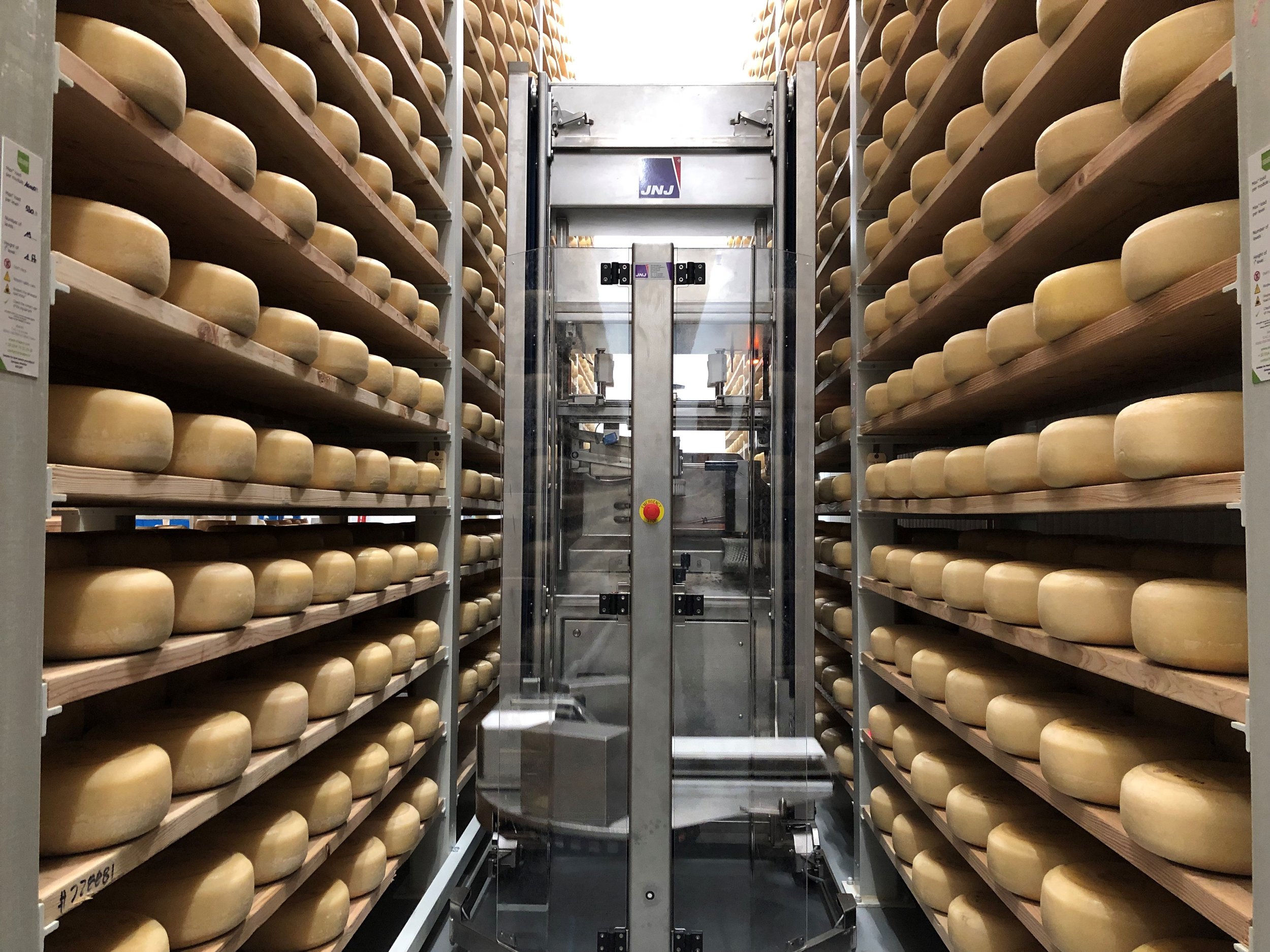Get to Know the Hard Working Cheese Robots with Truly Adorable Names
The Tina Turner cheese robot at Pt Reyes Farmstead Cheese.
Cheese lovers are probably familiar with the basic steps of the cheesemaking process. While traditionally it was all done by humans, machines are used to handle much of the backbreaking work today including robots which are used for milking cows, and in the packaging of cheese. What you might not know? Some parts of the actual cheesemaking and aging process are also done by robots. Here’s how robots are being used to make some of the finest specialty and artisan cheeses.
Heavy Lifting, Spraying & Brushing
“Most of the European cheese consumers enjoy is matured by robots,” says Mateo Kehler, head cheesemaker at Vermont’s Jasper Hill Farm. “This isn’t some brand new idea.” He explains that at Jasper Hill Farm, robots are used to “take some of the body-breaking labor out of the equation.”
Whitney photo credit Jasper Hill Farm
“At any given time, we have 20,000 to 25,000 wheels of cheese, each weighing 22-26 pounds, all handled on a weekly basis,” he says. “We bought a Swiss-made robot several years ago. It picks wheels of cheese off of the shelf, turns them, and brushes them. For a cheese like Whitney, it sprays brine or wine solution on cheese, and then washes them.”
“We used to do all this work by hand, but the physical toll was defeating us—we didn’t want to be in the business of wearing people out. We want to harness people to do the work that only people can do, like understanding what’s happening on the rind of cheeses and making decisions.”
Tina Turner the robot photo credit Point Reyes Farmstead Cheese Co
In California, Pt Reyes Farmstead Cheese got their cheese robot in 2019 and sponsored a contest on Instagram not long afterwards to name it. Responsible for flipping and brushing large wheels of cheese, it’s named Tina Turner.
In Wisconsin, cheesemaker Emmi Roth uses a robot named Neuchâtel to move cheese from production to affinage. Cheese is automatically loaded onto the robot, transported into the cellars, and placed on racks, which are up to 24 feet high. When the cheese is fully matured, the robot reverses the process and removes each wheel. “Doing that work by hand is something of the past, which is a really good thing,” says production supervisor Alex Koprowski. “Using robots reduces injury and increases safety.”
Smear Ripening
Emmi Roth also utilizes robots in affinage, with 4 smear robots named Bern, Luzerne, Solothurn, and Zurich (like Neuchâtel, all names of cities or towns in Switzerland). Koprowski explains that a human employee manually drives the robot into the aging cellar and programs it based on the age of the cheese. Then the robot pulls out each wooden cheese board and applies a culture to help develop the rind on the cheese.
Cleaning
Riccardo Deserti, general manager of the Parmigiano Reggiano Consortium, notes that while many aspects of making Parmigiano Reggiano are governed by rules that mandate traditional, craft processes, new technologies like robots can be used to improve certain steps. For example, robots are used to clean wheels during the aging process. “Generally, the number of wheels in storage is 10,000 to 15,000,” he says. “For larger producers, it is up to 400,000 to 500,000 wheels. For the safety of employees, these activities are totally mechanized.”
Advantages to Using Robots
In addition to improving worker safety, one of the major advantages of using robots in cheesemaking is consistency. “Our quality went way up when we started using robots [to brush our cheeses],” says Kehler. “Subtle differences in brush pressure and technique [by human workers] created variability in rind formation.”
Koprowski has observed similar outcomes. “Using robots controls the aging process better, and really drives a more consistent, better quality product.”
Although they have been using affinage robots for over 40 years, the Parmigiano Reggiano Consortium continues to innovate with new technologies. Efforts include a partnership with p-Chip Corporation and Kaasmerk Matec to label Parmigiano Reggiano cheese wheels with a food-safe digital tag that will assist with inventory tracking, quality-assurance testing, and product authentication.
“This is the new technological frontier in our process,” says Deserti. “A label is applied on the rind when the wheel is born, and since these labels are unique we can check all the procedures for the production and also guarantee against counterfeiting.”
Similarly, at Jasper Hill Farms, the latest innovations are a tool to support artisanal cheesemaking.
“We’ve been leaning into the idea that we can use science and technology to defend traditional practices,” says Kehler. “For instance, Alpha Tolman is a cheese that is made from raw milk from a hay-fed herd of cows pastured in the summer, using very traditional, primordial cheesemaking techniques—all wild starters, kind of like natural cheesemaking. It’s made in traditional copper vats, but a state of the art cheese molding system enables us to take a lot of the variability out of the molding process.”
“That’s typical of what our ambitions in cheese are: using technology to take the back-breaking labor out and give us the process control to highlight the milk and cool traditional practices that happen upstream in the cheesemaking process.”


